
Sculpture is the branch of the visual arts that operates in three dimensions. Sculpture is the three-dimensional art work which is physically presented in the dimensions of height, width and depth. It is one of the plastic arts. Durable sculptural processes originally used carving and modelling, in stone, metal, ceramics, wood and other materials but, since Modernism, there has been almost complete freedom of materials and process. A wide variety of materials may be worked by removal such as carving, assembled by welding or modelling, or moulded or cast.

Lee Oscar Lawrie was an American architectural sculptor and an important figure in the American sculpture scene preceding World War II. Over his long career of more than 300 commissions Lawrie's style evolved through Modern Gothic, to Beaux-Arts, Classicism, and, finally, into Moderne or Art Deco.
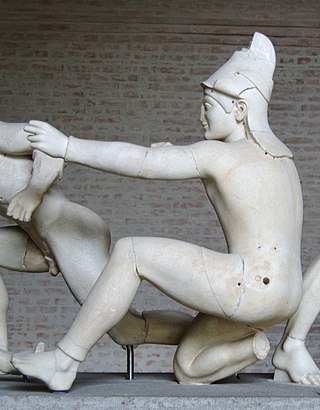
Marble has been the preferred material for stone monumental sculpture since ancient times, with several advantages over its more common geological "parent" limestone, in particular the ability to absorb light a small distance into the surface before refracting it in subsurface scattering. This gives an attractive soft appearance that is especially good for representing human skin, which can also be polished.

Charging Bull, sometimes referred to as the Bull of Wall Street or the Bowling Green Bull, is a bronze sculpture that stands on Broadway just north of Bowling Green in the Financial District of Manhattan in New York City. The 7,100-pound (3,200 kg) bronze sculpture, standing 11 feet (3.4 m) tall and measuring 16 feet (4.9 m) long, depicts a bull, the symbol of financial optimism and prosperity. Charging Bull is a popular tourist destination that draws thousands of people a day, symbolizing Wall Street and the Financial District.

The Kiss is an 1882 marble sculpture by the French sculptor Auguste Rodin.
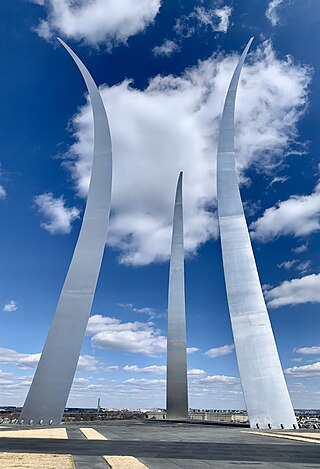
The United States Air Force Memorial honors the service of the personnel of the United States Air Force and its heritage organizations. The Memorial is located in Arlington County, Virginia, on the former grounds of the Navy Annex near The Pentagon and Arlington National Cemetery. The Memorial is southwest of the intersection of Columbia Pike and South Joyce Street and is accessible from the north side of Columbia Pike. It was the last project of American architect James Ingo Freed with the firm Pei Cobb Freed & Partners.

Marshall Maynard Fredericks was an American sculptor known for such works as Fountain of Eternal Life, The Spirit of Detroit, Man and the Expanding Universe Fountain, and many others.
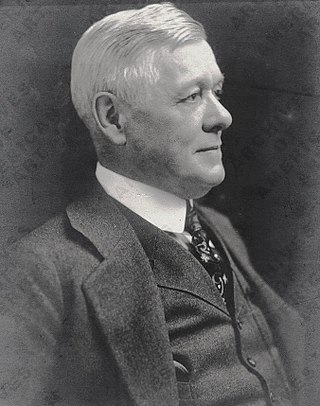
John Massey Rhind was a Scottish-American sculptor. Among Rhind's better known works is the marble statue of Dr. Crawford W. Long located in the National Statuary Hall Collection in Washington D.C. (1926).

Francis Derwent Wood was a British sculptor.

Zenos Frudakis, known as Frudakis, is an American sculptor whose diverse body of work includes monuments, memorials, portrait busts and statues of living and historic individuals, military subjects, sports figures and animal sculpture. Over the past four decades he has sculpted monumental works and over 100 figurative sculptures included within public and private collections throughout the United States and internationally. Frudakis currently lives and works near Philadelphia, and is best known for his sculpture Freedom, which shows a series of figures breaking free from a wall and is installed in downtown Philadelphia. Other notable works are at Arlington National Cemetery in Virginia, Brookgreen Gardens in South Carolina, the National Academy of Design, and the Lotos Club of New York City, the Imperial War Museum in England, the Utsukushi ga-hara Open Air Museum in Japan, and the U.S. Embassy in Pretoria, South Africa.
Reaching is a public artwork by artist Zenos Frudakis, located in downtown Indianapolis, Indiana, United States. It is a figurative bronze portrait of a nude male and female. Each figure is leaping and reaching, arms outstretched toward the other.
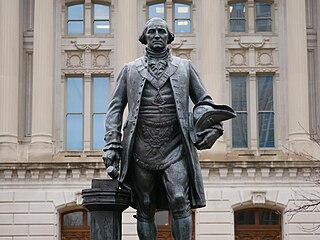
George Washington is a public artwork by American sculptor Donald De Lue, located on the grounds of the Indiana Statehouse, in Indianapolis, Indiana, United States. The bronze statue of George Washington that occupies the Indiana Statehouse south lawn is one of several copies of a 1959 original wax cast at the Modern Art Foundry in Long Island, New York.
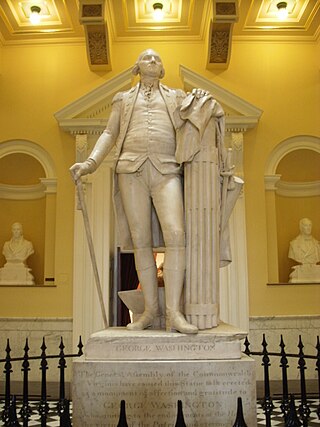
George Washington is a statue by the French sculptor Jean-Antoine Houdon from the late 18th century. Based on a life mask and other measurements of George Washington taken by Houdon, it is considered one of the most accurate depictions of the subject. The original sculpture is located in the rotunda of the Virginia State Capitol in Richmond, Virginia, and it has been copied extensively, with one copy standing in the United States Capitol Rotunda.
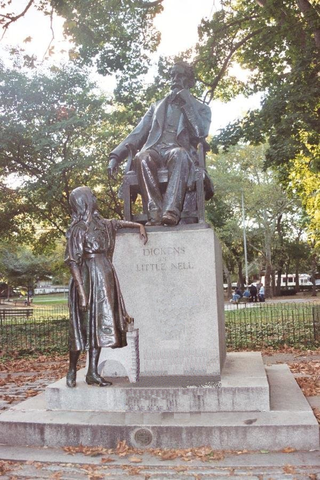
Dickens and Little Nell is a bronze sculpture by Francis Edwin Elwell that stands in Clark Park in the Spruce Hill neighborhood of Philadelphia. The sculpture depicts the 19th-century British author Charles Dickens and Nell Trent, a character from his 1840–41 novel The Old Curiosity Shop. The grouping was one of the most celebrated American sculptural works of the late 19th century.

A bronze sculpture of American pioneer, newspaper editor and historian Harvey W. Scott (1838–1910) by Gutzon Borglum, sometimes called Harvey Scott or Harvey W. Scott, was installed on Mount Tabor in Portland, Oregon, United States, until being toppled in October 2020.
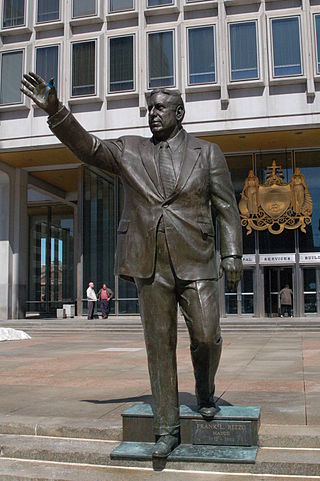
A statue of Frank Rizzo, sometimes called the Frank L. Rizzo Monument, was installed in Philadelphia, in the U.S. state of Pennsylvania. Erected in 1998, the bronze sculpture was removed in June 2020. Black Lives Matter activists and others protested the statue's presence, and the statue was taken down during the George Floyd protests.

The Emancipation Memorial, also known as the Freedman's Memorial or the Emancipation Group was a monument in Park Square in Boston. Designed and sculpted by Thomas Ball and erected in 1879, its sister statue is located in Lincoln Park in the Capitol Hill neighborhood of Washington, D.C. The Boston statue was taken down by the City of Boston on December 29, 2020, following a unanimous vote from the Boston Art Commission on June 30 to remove the memorial.

Feltépve was a 2014 outdoor temporary sculpture located in Széchenyi Square in Budapest, Hungary, by Ervin Hervé-Lóránth. The artwork depicted a giant man emerging from the earth, and was installed as part of the 2014 Art Market Budapest.
Ervin Hervé-Lóránth, often known mononymously as Hervé, is a Hungarian visual artist and creator of several Hungarian and international art exhibitions. He currently serves as a cultural attaché of Hungary. He is also a cultural anthropologist, and an interior architect. The sculptures have been referred to as temporary art, but Hervé-Lóránth refers to his outdoor sculptures as "public surprises".
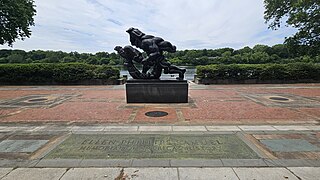
The Ellen Phillips Samuel Memorial is a sculpture garden located in Fairmount Park in Philadelphia, Pennsylvania, United States. The garden, located along the left bank of the Schuylkill River between Boathouse Row and the Girard Avenue Bridge, was established by the Fairmount Park Art Association and dedicated in 1961.




















